I recently spoke at a CLE on things to think about when litigating a case from initial intake all the way through trial. My presentation on visuals was sandwiched between a presentation on voir dire and a presentation on opening statements. As I told the audience, that scheduling was ironically appropriate because that is the time when many attorneys first think about how to use visuals in their case.
While I was joking, there was a nugget of truth in what I said. I am continually surprised at how late in the process most people begin to think about what sort of visuals might help them prove their case. Most often, clients contact us a few weeks before trial. We can always help them but if you are not thinking about visuals from day one in your case, that is a mistake. You are missing opportunities to not only develop your case fully but also forgoing a chance to force an early settlement.
Now, to be clear, I’m not saying you should prepare demonstrative exhibits before your case is filed. What I am saying is you should, at a minimum, analyze your case visually (as I described last week) at a very early point in your case.
I’m going to give you five solid reasons to do that. I’m confident if you take my advice, your cases will be better constructed and your clients will be better served than if you treat visuals as something to consider only on the eve of trial.
- You want to obtain and preserve necessary images before the opportunity passes.
If you do not think about your case visually early in its life, you may miss key opportunities to capture images and data needed to create compelling visuals later in your case. Often an intersection, accident scene, or piece of equipment needs to be captured by photographs or more comprehensive data-retrieval methods such as laser scans. Key elements of a case, such as the positioning of a tree branch overhanging an intersection, the configuration of a road shoulder, or the absence of a safety mechanism on a machine can change.
If you do not collect the information before it disappears, it is more difficult to create accurate and admissible visuals later in the case. And even if you do not use the data or images when you first collect them, you will have preserved them for later use.
- Your depositions will be more focused.
It is good practice to use rudimentary visuals, or at least be thinking of visuals, when you are taking depositions. This has many benefits. It focuses you on what you need from a witness, assists in shaping testimony to conform to your preferred narrative, and helps you understand precisely where witnesses differ on key points.
Too often, a client comes to us on the eve of trial seeking a complex visual, and we discover that depositions in the case are unhelpful because no thought was given to using the testimony to build a visual foundation. The exhibits are confusing, and often hand-drawn, and the questions are insufficiently sharp or leave significant gaps in the evidence. You can avoid this by having visuals in mind or in hand, and asking questions designed to focus on visual details.
- If you create your visuals early, you can test and improve them.
One key reason to use demonstrative evidence early in a case is that it gives you a chance to draw out any objections and address them well before trial. And if you use a visual at depositions, in expert reports, or in motion practice that draws no objections, it is going to be significantly more difficult for your opponents to object to it at trial. This is especially true for charts, drawings, or animations that you have disclosed in an expert report and that your opponents have had an opportunity to depose your expert about.
- You can bring some zing to your pleadings.
Ask yourself this: if a visual is important enough to use on an issue at trial, why would you not use that same visual to persuade the court on motion practice? You should always consider including your visuals with your briefs. They will make your filings stand out with judges and clerks, and gives them additional reason to interact with your arguments and your version of the facts. It also plays into the strategic use of demonstrative exhibits because you will almost certainly learn of any objections.
- Strong visuals push cases toward settlement.
We have increasingly seen our clients have success using visuals and demonstrative materials early in cases, and especially at mediation, to drive settlements. By using even a rough mockup of your visuals, you can demonstrate the persuasiveness of your position and make it clear that you are ready to proceed to trial if needed.
So, there you have it. Five solid, commonsense reasons you should be thinking about your case visually from day one. And as always, Cogent Legal is here to help you navigate any part of this process you need help with.


